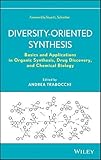Diversity-oriented synthesis : basics and applications in organic synthesis, drug discovery, and chemical biology / edited by Andrea Trabocchi.
Material type: TextPublisher: Hoboken, New Jersey : Wiley, [2013]Description: 1 online resourceContent type:
TextPublisher: Hoboken, New Jersey : Wiley, [2013]Description: 1 online resourceContent type: - text
- computer
- online resource
- 9781118618141
- 1118618149
- 9781118617946
- 1118617940
- 9781118618073
- 1118618076
- 9781118618110
- 1118618114
- 1299732569
- 9781299732568
- 1118145658
- 9781118145654
- 547/.2 23
- QD262
- SCI013040
"This book overviews diversity-oriented synthesis (DOS), one of the leading and dynamic topics in organic chemistry and drug discovery"-- Provided by publisher.
Includes bibliographical references and index.
Machine generated contents note: Foreword Stuart L. Schreiber Preface List of Contributors Abbreviations 1 The Basics of Diversity-Oriented Synthesis Kieron M.G. O'Connell, Warren R.J.D. Galloway and David R. Spring 1.1 Introduction 1.2 What is Diversity-Oriented Synthesis? 1.3 Small Molecules and Biology 1.4 Comparing DOS, TOS and Combinatorial Chemistry (Focused Library Synthesis) 1.5 Molecular Diversity 1.6 Molecular Diversity and Chemical Space 1.7 Synthetic Strategies for Creating Molecular Diversity 1.8 Reagent-Based Approaches to Diversity Generation 1.9 A Substrate-Based Approach to Skeletal Diversity Generation 1.10 Other Build/Couple/Pair Examples 1.11 Concluding Remarks 1.12 References Part I Chemical Methodology in Diversity-Oriented Synthesis 2 Strategies Applications of Multicomponent Reactions (MCRs) to Diversity-Oriented Synthesis John M. Knapp, Mark J. Kurth, Jared T. Shaw and Ashkaan Younai 2.1 Introduction 2.2 MCR Products for HTS 2.3 MCRs as Starting Points for DOS 2.4 Conclusion 2.5 References 3 Cycloaddition Reactions in Diversity-Oriented Synthesis Giovanni Muncipinto 3.1 Introduction 3.2 [4+2] Cycloaddition Reactions 3.3 Diels-Alder Reaction 3.4 Inverse Electron Demand Diels-Alder Reaction 3.5 1,3-dipolar Cycloaddition Reactions 3.6 Miscellaneous Cycloadditions 3.7 Conclusion 3.8 References 4 Phosphine Organocatalysis as the Platform for Diversity-Oriented Synthesis Ohyun Kwon and Zhiming Wang 4.1 Introduction 4.2 DOS using Phosphine Organocatalysis 4.2.1 Phosphine Organocatalysis of Allenes with Imines 4.3 Skeletal Diversity Based on a Phosphine Catalysis/Combinatorial Scaffolding Strategy 4.4 A DOS Library Based on Phosphine Organocatalysis: Biological Screening, Analogue Synthesis, and Structure-Activity Relationship Analysis 4.5 Conclusions 4.6 References 5 Domino Reactions in Library Synthesis Matthew G. LaPorte, John R. Goodell, Sammi Tsegay and Peter Wipf 5.1 Introduction 5.2 Pericyclic Domino Reactions 5.3 Anionic Domino Reactions 5.4 Transition Metal Mediated Domino Reactions 5.5 Radical Domino Reactions 5.6 Conclusions 5.7 References 6 Diversity-Oriented Synthesis of Amino Acid-Derived Scaffolds and Peptidomimetics: A Perspective Andrea Trabocchi 6.1 Introduction 6.2 Definition and Classification of Peptidomimetics 6.3 Early Combinatorial Approaches to Peptidomimetic Scaffolds 6.4 Amino Acid-Derived Scaffolds 6.5 Macrocyclic Peptidomimetic Scaffolds 6.6 Conclusion 6.7 References 7 Solid-phase Synthesis Enabling Chemical Diversity Viktor Krchňák and Nadĕ Cankařová 7.1 Introduction 7.2 Skeletal Diversity 7.3 Substrate-Based Strategy (Folding Process) 7.4 Stereochemical Diversity 7.5 Appendages Diversity 7.6 Build/Couple/Pair Strategy 7.7 Scaffold Hopping 7.8 Conclusion 7.9 References 8 Macrocycles as Templates for Diversity Generation in Drug Discovery Eric Marsault 8.1 Introduction 8.2 Challenges Associated with Macrocycles 8.3 Macrocyclic Peptides 8.4 Peptidomimetic Macrocycles 8.5 Diversity-Oriented Strategies Based on Nonpeptidic Natural Products 8.6 Conclusion 8.7 References Part II Chemical Libraries and Diversity-Oriented Synthesis 9 Diversity-Oriented Synthesis of Natural Product-Based Libraries Mark Dow, Francesco Marchetti and Adam Nelson 9.1 Introduction 9.2 Libraries Inspired by Natural Product Scaffolds 9.3 Folding Pathways in the Synthesis of Natural Product-Like Libraries 9.4 Branching Pathways in the Synthesis of Natural Product-Like Libraries 9.5 Oligomer-Based Approaches to Natural Product-Like Libraries 9.6 Summary 9.7 References 10 Chemoinformatic Characterization of the Chemical Space and Molecular Diversity of Compound Libraries Jose Luis Medina-Franco 10.1 Introduction 10.2 Concept of Chemical Space 10.3 General Aspects of Chemoinformatic Methods to Analyze the Chemical Space 10.4 Chemoinformatic-Based Analysis of Libraries Using Different Representations 10.5 Recent Trends in Computational Approaches to Characterize Compound Libraries 10.6 Concluding Remarks 10.7 References 11 DNA-Encoded Chemical Libraries Luca Mannocci 11.1 Introduction 11.2 DNA-Encoded Chemical Libraries (DECL) 11.3 Selection and Decoding 11.4 Drug Discovery by DNA-Encoded Chemical Libraries 11.5 DNA-Encoded Chemical Libraries: Prospects and Outlook 11.6 Conclusion 11.7 References PART III Screening Methods and Lead Identification 12 Experimental Approaches for Rapid Profiling and Characterization of Specific Biological Effects of Diversity-Oriented Synthesis Compounds Eduard A. Sergienko and Susanne Heynen-Genel 12.1 Introduction 12.2 Basic Principles of HTS 12.3 Common Assay Methods and Techniques 12.4 Future Perspectives 12.5 References 13 Small-Molecule Microarrays Hongyan Sun 13.1 Introduction 13.2 Chemical Library Design and Synthesis 13.3 Fabrication of SMMs 13.4 Applications of SMM 13.5 Summary and Outlook 13.6 References 14 Yeast as a Model in High-Throughput Screening of Small Molecule Libraries Duccio Cavalieri, Carlotta De Filippo and Irene Stefanini 14.1 Introduction 14.2 Chemical Genetics and S. cerevisiae 14.3 Chemical Genomics and S. cerevisiae 14.4 Conclusions: the Route of Drug Discovery with the Budding Yeast 14.5 References 15 Virtual Screening Methods Jurgen Bajorath 15.1 Introduction 15.2 Basic Virtual Screening Concepts 15.3 Molecular Similarity in Virtual Screening 15.4 Spectrum of Virtual Screening Approaches 15.5 Docking 15.6 Similarity Searching 15.7 Compound Classification 15.8 Machine Learning 15.9 Conclusions 15.10 References 16 Structure-Activity Relationship Data Analysis: Activity Landscapes and Activity Cliffs Jurgen Bajorath 16.1 Introduction 16.2 Numerical SAR Analysis Functions 16.3 Principles and Intrinsic Limitations of Activity Landscape Design 16.4 Activity Landscape Representations 16.5 Defining and Identifying Activity Cliffs 16.6 Activity Cliff Survey 16.7 Activity Cliffs and SAR Information 16.8 Concluding Remarks 16.9 References PART IV Applications in Chemical Biology and Drug Discovery 17 Diversity-Oriented Synthesis and Drug Development: Facilitating the Discovery of Novel Probes and Therapeutics Jeremy R. Duvall, Eamon Comer and Sivaraman Dandapani 17.1 Introduction 17.2 Case Study 1 -- Inhibition of Cytokine-Induced [symbol for a square]-Cell Apoptosis 17.3 Case Study 2 -- Identification of Anti-Malarials 17.4 Case Study 3 -- Targeting Protein-Protein and Protein-DNA Interactions 17.5 Conclusion 17.6 References 18 DOS-Derived Small-Molecule Probes in Chemical Biology Nicholas Hill, Lingyan Du and Qiu Wang 18.1 Introduction 18.2 DOS-Derived Small-Molecule Probes 18.3 Developing Small-Molecule Probes of Complex Biological Pathways 18.4 Expanding the Collection of Important Biological Probes 18.5 Developing Probes for Therapeutically Desirable Phenotypes 18.6 Natural Product-Inspired Small-Molecule Probes Developed from DOS and Biology-Oriented Synthesis 18.7 Summary and Outlook 18.8 References Index.
Print version record and CIP data provided by publisher.
Life Sciences
